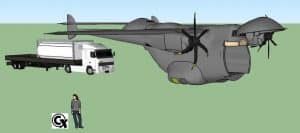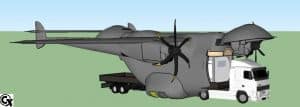"From truck to plane"
A New Paradigm in Airborne Container Transport
ISO-Plane is a future aircraft. Project is to achieve first TRL and prove technical faisability of this innovant way to andle container on airports. ISO-Plane can take and drop an 20 feets container from a truck trailer or directly from ground. Logistic operation are simplified. 20 feets ISO container are the most commun container used for civiles forces. It will increase air obility when reacting to humanitarian and environmental crisis. There is no need to specific manutention tools, cranes or trolley. Container is dropped on the truck from the plane.

There are several ways to transport a container by aircraft, depending on the size and weight of the container and the type of aircraft being used. Here are a few options:
Cargo aircraft: Large cargo planes, such as the Boeing 747 or the Airbus A380, are designed specifically for the transportation of goods, including containers. These aircraft have a cargo hold that can accommodate a wide range of sizes and shapes of containers, which can be loaded and unloaded using specialized equipment such as cranes or forklifts.
Air freight services: Air freight companies offer services for the transportation of containers and other goods by air. These companies typically have a fleet of cargo aircraft that are used to transport containers to and from airports around the world.
Military aircraft: Military aircraft, such as transport planes and cargo helicopters, can also be used to transport containers. These aircraft are often equipped with specialized equipment for loading and unloading containers and are capable of operating in a variety of environments.
Passenger aircraft: In some cases, it may be possible to transport a container on a passenger aircraft. Many passenger planes have cargo holds that can accommodate small to medium-sized containers, and air freight companies may offer services for the transportation of these types of containers on passenger planes.
The most suitable method for transporting a container by aircraft will depend on the size and weight of the container, the distance it needs to travel, and the specific requirements of the shipment.
Why a 20 feet contener does not fit into a civilian aircraft ?
It can be difficult to transport a 20-foot standard container with a civilian or military aircraft for several reasons:
Size: A 20-foot standard container is quite large, and may not fit easily into the cargo hold of a civilian or military aircraft. Many aircraft are designed to carry smaller loads, and may not have the capacity to accommodate a container of this size.
Weight: A 20-foot standard container can weigh several thousand pounds, and this may be too heavy for some aircraft to carry. Civilian and military aircraft are designed to carry specific loads, and exceeding these limits can be dangerous and can put undue strain on the aircraft’s structure and systems.
Shape: A 20-foot standard container is a long and rectangular object, which may not fit easily into the cargo hold of an aircraft. Some aircraft are designed to carry specific types of cargo, such as pallets or rolls of material, and may not have the necessary space or handling equipment to accommodate a container of this shape.
Loading and unloading: A 20-foot standard container can be difficult to load and unload from an aircraft, especially if the aircraft does not have the necessary handling equipment or if the container is too large or heavy to be moved easily. This can be a significant challenge for both civilian and military aircraft, which may need to load and unload cargo quickly in order to meet operational requirements.
Overall, it can be difficult to transport a 20-foot standard container with a civilian or military aircraft due to its size, weight, shape, and the challenges involved in loading and unloading it. While it is possible to transport a container of this size on some aircraft, it may require specialized handling equipment and may be subject to certain restrictions or limitations.
Iso-Plane.com is at the forefront of revolutionizing airborne container transport, introducing a patented method that facilitates the loading and unloading of 20-foot ISO containers without the need for specialized handling equipment. Our goal is to simplify logistics operations at airports, making air transport more accessible and responsive to humanitarian and environmental crises.
The Impact of Iso-Plane on Humanitarian Operations
Iso-Plane promises to transform the way aid is deployed in emergency situations. By enabling aircraft to directly pick up and drop off standard containers at any location, including remote areas, it significantly cuts down response times. This capability is especially critical when rapid intervention is required, such as in the aftermath of natural disasters or in conflict zones where ground access may be compromised.
Innovating Beyond Traditional Air Cargo Methods
Unlike traditional air freight methods that depend on extensive and often unavailable ground infrastructure, Iso-Plane’s technology integrates seamlessly with existing logistics chains. It eliminates the need for cranes, forklifts, or additional ground handling which are often logistical bottlenecks in critical situations. By adopting Iso-Plane’s system, humanitarian operations can achieve a higher degree of flexibility and efficiency, ensuring that aid reaches those in need faster and more reliably.
Join us at Iso-Plane.com as we continue to redefine the boundaries of what is possible in air logistics. Stay connected for updates on our progress and breakthroughs, which are not only shaping the future of cargo handling but also enhancing global response capabilities to urgent crises.
Iso-Plane is committed to pushing the limits of aviation technology to serve humanity better. Contact us today to learn more about how our innovations can benefit your operations, or to become a part of our journey towards a more accessible and efficient future in air transport.


